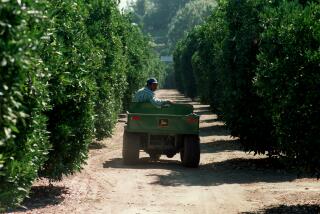Farmland Advocates Decry CSU Land Swap Proposal
CAMARILLO — A land-swap proposal aimed at generating money to help transform Camarillo State Hospital into a college campus has raised some concerns among community leaders, who say the plan would eat away at prime farmland and violate an agreement to preserve the greenbelt property.
The proposal calls for Cal State officials to trade a 260-acre lemon orchard near the California Youth Authority on Central Avenue for 280 acres of privately owned row crops sandwiched between the state hospital and the city of Camarillo.
After the transaction, Cal State officials propose leasing or developing the property, thereby generating cash to help pay for converting the aging mental institution into Ventura County’s first public university.
While the proposal is still in its formative stages, it already has met with resistance.
“I don’t know if [Cal State officials] have read the newspapers recently, but we have a concern about the agricultural industry in this county,” Ventura County Supervisor John Flynn said.
“It would have an eroding effect on the Santa Rosa Valley, and I think if that proposal were to come before members of any public board, they would have very serious concerns.”
For Cal State officials, however, the proposal is just one of a variety of income-generating ventures under consideration to help support the conversion project.
Officials have long maintained that the college campus must help pay its own way. To that end, they have proposed a range of enterprises on the hospital property needed to help transform the state hospital into a state-of-the-art university.
The land swap could be a logical extension of that, project manager Mary Stephens said.
The Cal State system owns the 260 acres and had won approval to build only a university there. But with their sights now set on the hospital property, CSU officials would not be able to build on the 260 acres.
Cal State officials say it has become clear that the only way to expand the university is to tap income-generating ventures off the proposed campus, a reality they note was acknowledged last year by a task force studying ways to reuse the hospital property.
“I’m not going to dispute that there are going to be some real concerns,” Stephens said. “Ultimately it’s the community’s decision. We just want to make sure everyone is fully informed about what it’s going to take to bring a university campus.”
More to Read
Sign up for Essential California
The most important California stories and recommendations in your inbox every morning.
You may occasionally receive promotional content from the Los Angeles Times.










